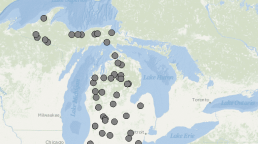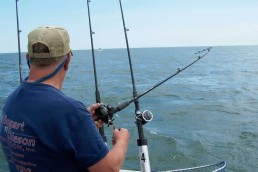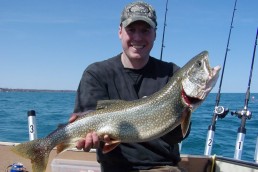Watching the Great Lakes Return to the Past
SHARE THIS POST
For fishermen, trying to understand what is happing in the Great Lakes these days is a mystery. It is a challenge even the best fisheries biologists are struggling to meet. The sheer geographical immensity of the lakes is daunting. Formed 14,000 years ago, the Great Lakes comprise the world’s largest freshwater system, containing 21 percent of all the fresh water on earth.
To most of us this is nearly incomprehensible, so let’s put it into layman’s terms: From east to west, the lakes span 750 miles with a water surface of 94,250 square miles, roughly the size of the United Kingdom. A drive around them would put 6,500 miles on your car’s odometer. And, there are approximately 35,000 islands in the Great Lakes.
Are you getting the picture now?
The water that recharges the five lakes derives primarily from snowmelt that pours out of rivers surrounding the basin. Before increased settlement, this water was uncontaminated and carried little nutrients with it; a large and diverse fish community had adapted to this relatively sterile environment. Lake trout were the top-of-the-line predators and huge lake sturgeons were abundant. Walleyes, bass, northern pike, and yellow perch also prospered. Prey fish included emerald shiner minnows, stickleback, sculpin, cisco, rainbow smelt and bloater chubs.
Things began to change when surges of immigrants established farms and communities around the lakes. Runoff of fertilizers from farms into the lakes substantially increased the nutrient content and industrialization discharged pollutants into many areas.
Commercial fishing was not a detrimental factor early on, mainly due to the primitive gear of the times. But, following WWII, nylon netting replaced the inefficient cotton nets, and, combined with depredation by invasive lamprey eels, the native lake trout were virtually wiped out within a few years.
About the same time, phosphorus, a principle ingredient in laundry detergents, was pouring into the lake carried by wastewater from cities and towns along the shores. The phosphorus acted as a fertilizer and promoted a huge upsurge in algae growth, which in turn fed burgeoning colonies of plankton and other microorganisms. The algae also created ‘blooms,” which strangled fish life over large areas of the lakes.
It was at this point, around 1950, which the alewives poured through the Welland Canal into the Great Lakes and found the ecology devoid of predators and overloaded with nutrients. Within a few years, these enterprising little shad comprised an estimated 95 percent of the entire fishery, by weight. The schools of alewives were so enormous that airline pilots flying over the lakes could see them.
Are you enjoying this post?
You can be among the first to get the latest info on where to go, what to use and how to use it!
In an effort to take advantage of this huge amount of forage fish, in 1965 Dr. Howard Tanner, Michigan DNR’s fishery chief, made the initial experimental stocking of coho salmon into Lake Michigan. Of course, it was enormously successful, and a few years later he followed up with the larger and longer-lived chinook salmon.
In 1960, the U.S. Fish and Wildlife service conducted a program of lake trout planting aimed at reviving natural reproduction of the original big lake predator. While the planted fish thrived, there had been no sign of naturally reproduced young trout.
Later, there was improvement until 1990, when the zebra mussels and European spiny water fleas were dumped into the Great Lakes in ocean-going freighters’ ballast water. This created a perfect storm as the heavily stocked chinooks, combined with an unsuspected population of wild chinooks from Michigan, relentlessly tore into the alewife schools and the mussels and water fleas devoured immense quantities of the algae and plankton the alewives depended on. In 2000, invasive quagga mussels showed up, and things got worse. The quagga were larger and covered more lake bottom than did the zebra mussels.
Additionally, back in the late 1980s, phosphorus discharge into the lakes was reduced, depleting the supply of fertilizer that promoted algae growth. The combination of mussels, water fleas, and lack of phosphorus significantly undercut the entire lake’s food chain upon which newly hatched fish relied on.
To make matters worse, over in adjoining Lake Huron the same thing had occurred several years earlier and the alewives had crashed, leaving that lake’s chinooks without prey fish. To survive, the Huron chinooks simply migrated into Lake Michigan where they helped to deplete those alewives by 90 percent, and currently shrinking fast. With Lake Ontario’s once- great chinook fishery experiencing the same fate, fishery managers now accepted the fact that the Great Lakes chinook fishery would never recover to its glory days.
Along with the demise of the alewives, smelt and emerald shiner minnow populations are also dwindling. The total biomasses of prey fish is at an all time low in Lake Michigan, ominously lower than Lake Huron. Since the chinook salmon’s diet consists almost entirely of alewives, it would appear as though their fate is all but sealed.
Meanwhile, the cohos and trout species have diversified their diets, and so far are doing better. The amazingly prolific invasive round goby is filling part of the gap created by the alewife collapse, and bloater chubs are also holding their own. Moreover, the lake trout having returned to their original diet of native prey fishes, are reproducing naturally on such an increasing scale that discussions have arisen about reducing or ending stocking programs in various areas of Lake Superior and Lake Huron. In Lake Michigan, creel surveys showed that 45 percent of the lake trout brought in by Illinois sport fishermen last season were wild (not fin-clipped) fish.
In the past 65 years, the Great Lakes has gone full circle, from murky, virtually empty water, to being stuffed with predators and prey fish. Now it’s almost back almost to its original state, with clear-water trout and native lake trout dominating the fishery. Guesses and theories abound as to where the Great Lakes fishery is headed, but after reviewing the recent past, who really knows?
MWO
SHARE THIS POST
Did you enjoy this post?
You can be among the first to get the latest info on where to go, what to use and how to use it!
Jerry Pabst
Jerry Pabst has been writing about the outdoors for over 40 years. He captained a Lake Michigan charter boat for 25 years and was inducted into the Fresh Water Fishing Hall of Fame. He has hunted waterfowl in all North American flyways, pursued upland game extensively, and trains his own dogs.


